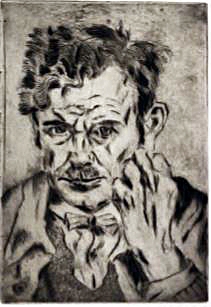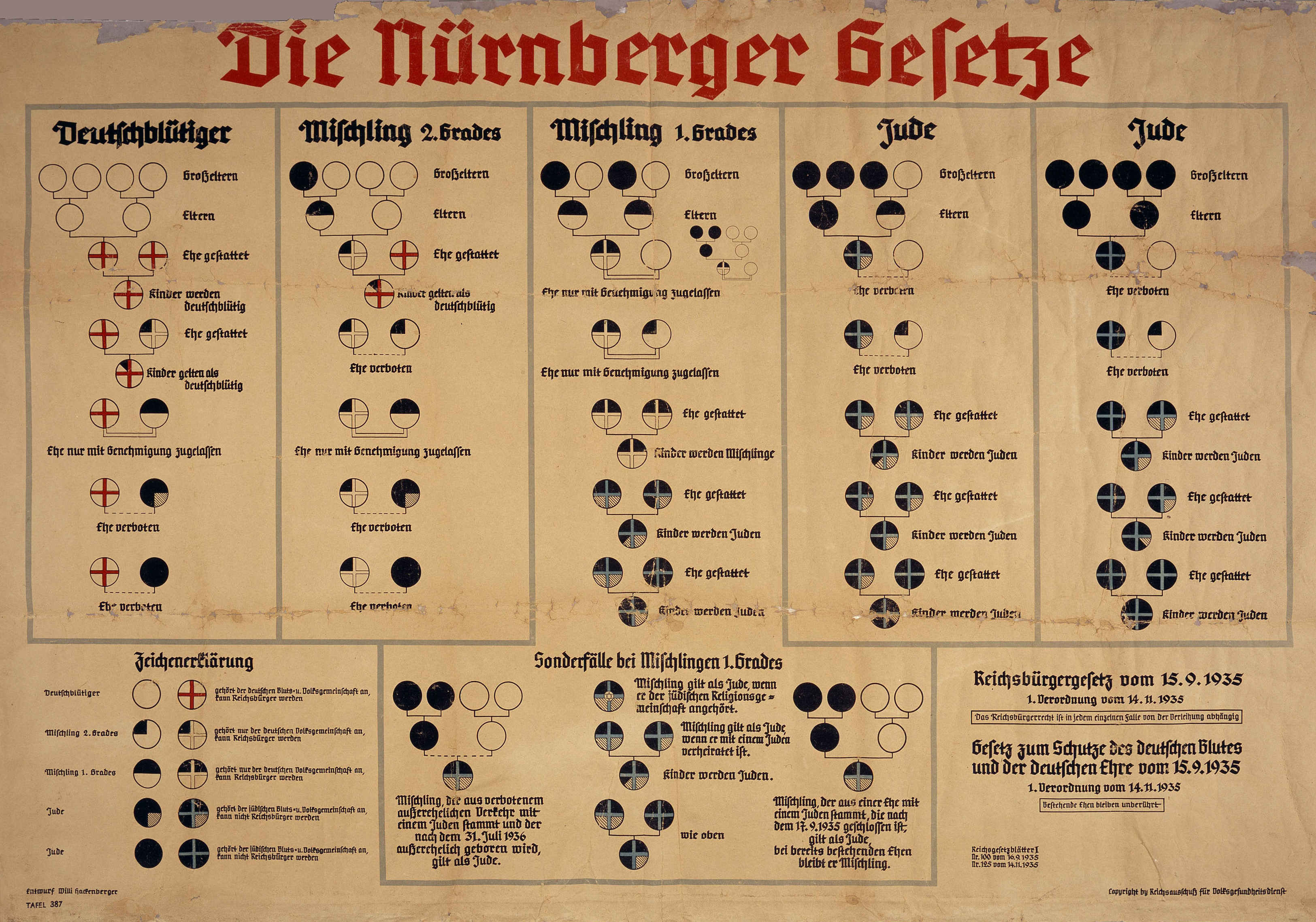|
Franz Monjau
Franz Monjau (30 January 1903, Cologne - 28 February 1945, KZ Buchenwald) was a German Expressionist painter and art teacher. Biography His father, Max Monjau, was a manufacturer from Barmen. His mother Paula, née Meyer, was the daughter of a Jewish wine merchant in Mainz. Both parents were practicing Catholics. Around 1910, the family moved to Düsseldorf where his father became chief representative for the cigarette maker, A. M. Eckstein Söhne. After completing his primary education, he enrolled at the Kunstakademie Düsseldorf, where he studied from 1922 to 1926; originally with Willy Spatz, then as a Master Student of Heinrich Nauen. As a free-lance painter, he became a member of Young Rhineland and later, the "Rheinischen Sezession". Both associations brought him into contact with members of the Communist Party of Germany (KPD). A major commission at GeSoLei was followed by two paintings for the Department of the History of Science, depicting Albertus Magnus and the ... [...More Info...] [...Related Items...] OR: [Wikipedia] [Google] [Baidu] |
University Of Cologne
The University of Cologne (german: Universität zu Köln) is a university in Cologne, Germany. It was established in the year 1388 and is one of the most prestigious and research intensive universities in Germany. It was the sixth university to be established in Central Europe. It closed in 1798 before being re-established in 1919. It is now one of the largest universities in Germany with more than 48,000 students. The University of Cologne was a university of excellence as part of the German Universities Excellence Initiative from 2012 to 2019. As of 2021, 3 Nobel Prize winners have been affiliated with the university. Professors and former students have won 11 Leibniz Prizes, the most prestigious as well as the best-funded prize in Europe. History 1388–1798 The university of Cologne was established in 1388 as the fourth university in the Holy Roman Empire, after the Charles University of Prague (1348), the University of Vienna (1365) and the Ruprecht Karl University of H ... [...More Info...] [...Related Items...] OR: [Wikipedia] [Google] [Baidu] |
1903 Births
Nineteen or 19 may refer to: * 19 (number), the natural number following 18 and preceding 20 * one of the years 19 BC, AD 19, 1919, 2019 Films * ''19'' (film), a 2001 Japanese film * ''Nineteen'' (film), a 1987 science fiction film Music * 19 (band), a Japanese pop music duo Albums * ''19'' (Adele album), 2008 * ''19'', a 2003 album by Alsou * ''19'', a 2006 album by Evan Yo * ''19'', a 2018 album by MHD * ''19'', one half of the double album ''63/19'' by Kool A.D. * ''Number Nineteen'', a 1971 album by American jazz pianist Mal Waldron * ''XIX'' (EP), a 2019 EP by 1the9 Songs * "19" (song), a 1985 song by British musician Paul Hardcastle. * "Nineteen", a song by Bad4Good from the 1992 album '' Refugee'' * "Nineteen", a song by Karma to Burn from the 2001 album ''Almost Heathen''. * "Nineteen" (song), a 2007 song by American singer Billy Ray Cyrus. * "Nineteen", a song by Tegan and Sara from the 2007 album '' The Con''. * "XIX" (song), a 2014 song by Slipknot. ... [...More Info...] [...Related Items...] OR: [Wikipedia] [Google] [Baidu] |
Stolperstein
A (; plural ; literally 'stumbling stone', metaphorically a 'stumbling block') is a sett-size, concrete cube bearing a brass plate inscribed with the name and life dates of victims of Nazi extermination or persecution. The project, initiated by the German artist Gunter Demnig in 1992, aims to commemorate individuals at exactly the last place of residency—or, sometimes, work—which was freely chosen by the person before they fell victim to Nazi terror, forced euthanasia, eugenics, deportation to a concentration or extermination camp, or escaped persecution by emigration or suicide. , 75,000 have been laid, making the project the world's largest decentralized memorial. The majority of commemorate Jewish victims of the Holocaust. Others have been placed for Sinti and Romani people (then also called "gypsies"), Poles, homosexuals, the physically or mentally disabled, Jehovah's Witnesses, black people, members of the Communist Party, the Social Democratic Party, and the a ... [...More Info...] [...Related Items...] OR: [Wikipedia] [Google] [Baidu] |
Peter Ludwigs
Peter Ludwigs (16 February 1888, Aachen – 3 July 1943, Düsseldorf) was a German sculptor and Expressionist painter. He is primarily known for his later, Anti-fascist paintings. Biography He was born into an old family of manufacturers. Initially, he studied sculpture at the (a Kunstgewerbeschule) and the Académie Royale des Beaux-Arts in Brussels. In 1911, he moved to Düsseldorf and got married. From 1915 to 1918, he was a voluntary participant in World War I, an experience that left him opposed to militarism. A year after his return, he joined the left-wing ''Aktivistenbund 1919'' ("Neuen Gesellschaft für künstlerische Kultur"). He was also one of the co-founders of "Young Rhineland". During this time, he turned from sculpture to painting; with an emphasis on social commentary. In 1922, he became a member of the Communist Party of Germany (KPD). Two years later, he was one of the co-founders of the satirical journal ''Die Peitsche'' (the whip). Together with and Gert ... [...More Info...] [...Related Items...] OR: [Wikipedia] [Google] [Baidu] |
Julo Levin
Julo Levin, originally Julius (5 September 1901, Stettin - 1943, KZ Auschwitz) was a German Expressionist painter of Jewish ancestry. Most of his surviving works are watercolors and sketches, however his family have some of his paintings. He was murdered in the Holocaust. Biography He showed an early aptitude for art and, from 1919, was already associated with artistic circles in the Rhineland. He studied at the Essen campus of the Folkwang University of the Arts with the Dutch artist, Johan Thorn Prikker; following him when he went to teach at the Royal Kunstgewerbeschule, Munich, in 1921. He transferred to the Kunstakademie Düsseldorf in 1923, where he was a Master Student of Heinrich Campendonk and Heinrich Nauen. Upon completing his studies in 1926, he received his first major commission: a mural for the GeSoLei. His earnings enabled him to make a study trip to Paris. In 1931, he would return to France; spending a summer in Marseille which was especially productive. ... [...More Info...] [...Related Items...] OR: [Wikipedia] [Google] [Baidu] |
Ohrdruf Concentration Camp
Ohrdruf was a German forced labor and concentration camp located near Ohrdruf, south of Gotha, in Thuringia, Germany. It was part of the Buchenwald concentration camp network. Operation Created in November 1944 near the town of Ohrdruf, south of Gotha, in Thuringia, Germany, Ohrdruf was initially a separate forced labour camp directly controlled by the SS Main Economic and Administrative Office (SS-WVHA) but then became a subcamp of the Buchenwald concentration camp near Weimar. It made use of huts originally built in 1940 for Wehrmacht troops using the ''Truppenübungsplatz'' nearby as well as other facilities. The camp, code-named ''Außenlager S III'', consisted of a northern and a southern camp; later, a tent camp at Espenfeld and a camp at Crawinkel were added. The camp supplied forced labor in the form of concentration camp prisoners for a planned railway construction project for an immense communications center inside the basement of the Mühlberg castle in Ohrdruf. Inma ... [...More Info...] [...Related Items...] OR: [Wikipedia] [Google] [Baidu] |
Gestapo
The (), abbreviated Gestapo (; ), was the official secret police of Nazi Germany and in German-occupied Europe. The force was created by Hermann Göring in 1933 by combining the various political police agencies of Prussia into one organisation. On 20 April 1934, oversight of the Gestapo passed to the head of the ''Schutzstaffel'' (SS), Heinrich Himmler, who was also appointed Chief of German Police by Hitler in 1936. Instead of being exclusively a Prussian state agency, the Gestapo became a national one as a sub-office of the (SiPo; Security Police). From 27 September 1939, it was administered by the Reich Security Main Office (RSHA). It became known as (Dept) 4 of the RSHA and was considered a sister organisation to the (SD; Security Service). During World War II, the Gestapo played a key role in the Holocaust. After the war ended, the Gestapo was declared a criminal organisation by the International Military Tribunal (IMT) at the Nuremberg trials. History After Adol ... [...More Info...] [...Related Items...] OR: [Wikipedia] [Google] [Baidu] |
Mischling
(; " mix-ling"; plural: ) was a pejorative legal term used in Nazi Germany to denote persons of mixed "Aryan" and non-Aryan, such as Jewish, ancestry as codified in the Nuremberg racial laws of 1935. In German, the word has the general denotation of hybrid, mongrel, or half-breed. Outside its use in official Nazi terminology, the term ''Mischlingskinder'' ("mixed children") was later used to refer to war babies born to non-white soldiers and German mothers in the aftermath of World War II. Nazi definitions of Mischling Since the Nazis were unable to find a racial definition of a "Jew", they instead relied on one's ancestors' religious backgrounds to determine whether someone was of "German or related blood" ("Aryan") or a "Jew" ("non-Aryan"). Thus, the Nuremberg Laws in 1935 defined a "full Jew" (''Istjude'' or ''Volljude'' in Nazi terminology) as a person – regardless of religious affiliation or self-identification – who had at least three grandparents who had been enro ... [...More Info...] [...Related Items...] OR: [Wikipedia] [Google] [Baidu] |
Theresienstadt
Theresienstadt Ghetto was established by the Schutzstaffel, SS during World War II in the fortress town of Terezín, in the Protectorate of Bohemia and Moravia (German occupation of Czechoslovakia, German-occupied Czechoslovakia). Theresienstadt served as a waystation to the extermination camps. Its conditions were deliberately engineered to hasten the death of its prisoners, and the ghetto also served a propaganda role. Unlike other ghettos, the Forced labor in Nazi Germany, exploitation of forced labor was not economically significant. The ghetto was established by the transportation of Czech Jews in November 1941. The first German Jews, German and Austrian Jews arrived in June 1942; Dutch Jews, Dutch and Danish Jews came at the beginning in 1943, and prisoners of a wide variety of nationalities were sent to Theresienstadt in the last months of the war. About 33,000 people died at Theresienstadt, mostly from malnutrition and disease. More than 88,000 people were held there for ... [...More Info...] [...Related Items...] OR: [Wikipedia] [Google] [Baidu] |
Draftsman
A drafter (also draughtsman / draughtswoman in British and Commonwealth English, draftsman / draftswoman or drafting technician in American and Canadian English) is an engineering technician who makes detailed technical drawings or plans for machinery, buildings, electronics, infrastructure, sections, etc. Drafters use computer software and manual sketches to convert the designs, plans, and layouts of engineers and architects into a set of technical drawings. Drafters operate as the supporting developers and sketch engineering designs and drawings from preliminary design concepts. Overview In the past, drafters sat at drawing boards and used pencils, pens, compasses, protractors, triangles, and other drafting devices to prepare a drawing by hand. From the 1980s through 1990s, board drawings were going out of style as the newly developed computer-aided design (CAD) system was released and was able to produce technical drawings at a faster pace. Many modern drafters now use co ... [...More Info...] [...Related Items...] OR: [Wikipedia] [Google] [Baidu] |









